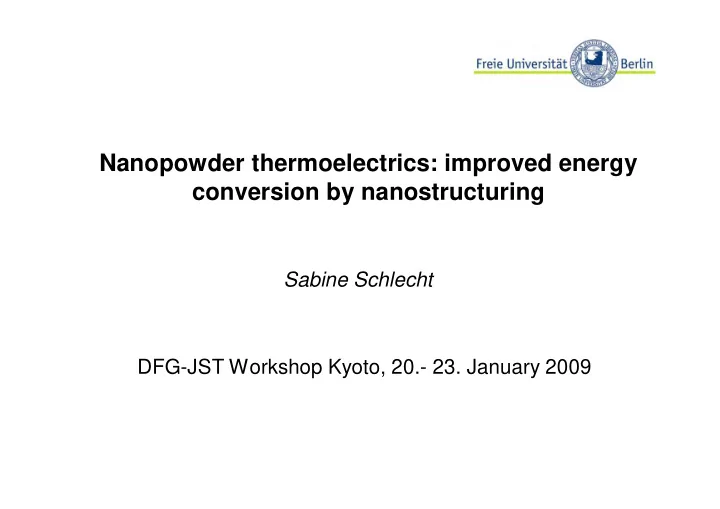

Nanopowder thermoelectrics: improved energy conversion by nanostructuring Sabine Schlecht DFG-JST Workshop Kyoto, 20.- 23. January 2009
Thermoelectric effects interconversion of thermal and electrical energy Seebeck 1821: difference in potential from a difference in temperature (TE generator) Peltier 1834: + - difference in temperature from a difference in potential (cooling)
Fields of application for TE converters Peltier element TEG for sensing TEG for vehicles RTG-New Horizons Woodstove with TEG
Nanoscale Thermoelectrics Efficiency of TE conversion (Altenkirch 1909): figure of merit ZT= (S 2 · σ )/ κ Why nano ? - reduction of κ - Influence on S and σ ? - concept of ‚electron crystal‘ and ‚phonon glass‘
Changes of TE parameters on the nanoscale Insulator Semiconductor Semimetal Metal S for nanoscale PbSe films bulk PbSe nano PbSe charge carrier concentration
Effects of nanostructuring on ZT multi quantum well structure in-plane transport electrical conductivity ordered super lattice cross-plane transport thermal conductivity
Super lattices of layers and quantum dots pioneered by Harman, Venkatasubramanian
Reduction of the thermal conductivity by phonon scattering R. Yang, G. Chen, M. S. Dresselhaus
Types of nanocomposite powders C B A
TE data for nano-Bi 0.5 Sb 1.5 Te 3 SEM image TEM image
TE data for nano-Bi 0.5 Sb 1.5 Te 3 σ (nano) slightly higher than σ (bulk) κ (nano) significantly lower than κ (bulk) - effective phonon scattering at a large number of grain boundaries - doping level and structural defects Improvement of the figure of merit ZT (nano) (200 ° C) = 1.1 ZT (bulk) (200 ° C) = 0.4 B. Poudel, Q. Hao, Y. Lan, A. Minnich, Z. Ren, Science, 2008 , 305 , 638.
Nanoscopic de-mixing: formation of a nanocomposite (LAST materials) - averaged rock salt structure - Ag- und Sb-rich nanoscopic inclusions - very effective phonon scattering - ZT values up to 2.2 M. G. Kanatzidis, Michigan State
Syntheses from activated elements Tellurides 165 ° C Pb* + Ph 2 Te 2 nc-PbTe + Ph 2 Te diglyme 165 ° C 2 Sb* + 3 Ph 2 Te 2 nc-Sb 2 Te 3 + 3 Ph 2 Te diglyme Antimonides (solid-solid reactions) 300 ° C/275 ° C 4 Zn* + 3 Sb* nc-Zn 4 Sb 3 300 ° C Zn* + Sb* nc-ZnSb 300 ° C Co* + 3 Sb* nc-CoSb 3
ZnSb nanopowders (13 nm) [021] 20 nm 2 nm particle size ~ 13 nm
Compacting and TE data for nc-ZnSb - Uniaxial hot-pressing (450 ° C, 100 MPa): stable samples with a density of 4.9 g/cm 3 - Seebeck coefficient S = 253 ± 2 μ V/K (bulk: 196 μ V/K) [1] 300 300 y0 0 xc 253.13 ±1.07 250 w 80.54 ±2.14 250 R^2 = 0.9797 Times measured 200 200 σ ( Ω -1 cm -1 ) 150 150 100 100 50 bulk-ZnSb nc-ZnSb 0 50 50 100 150 200 250 300 350 400 0 50 100 150 200 250 300 350 400 Seebeck coefficient [µV/K] T ( ° C) S 2 σ = 6.8 μ W/(K 2 cm) nc-ZnSb S 2 σ = 3.5 μ W/(K 2 cm) bulk-ZnSb [1] [1] P. J. Shaver, J. Blair, Phys. Rev. 1966 , 141 , 649.
Compacting and TE data for nc-ZnSb - Uniaxial hot-pressing (450 ° C, 100 MPa): stable samples with a density of 4.9 g/cm 3 - Seebeck coefficient S = 253 ± 2 μ V/K (bulk: 196 μ V/K) [1] 2,6 2,5 ZT (293 K) = 0.100 nc-ZnSb 2,4 κ [W/(m·K)] 2,3 ZT (293 K) = 0.044 bulk-ZnSb 2,2 ZT (nano) = 2.2 ZT (bulk) 2,1 nc-ZnSb 2,0 [1] P. J. Shaver, J. Blair, Phys. Rev. 1966 , 141 , 649. 0 50 100 150 200 250 300 T ( ° C) [2] L. T. Zhang, M. Tsutsui, J. All. Comp. 2003 , 358 , 252.
Influence of the method of compacting: ZnSb (20 nm) S(T) for HUP and SPS S-scan after one thermal cycle 140 y0 15.71279 ± 3.90351 density 4.7 g/cm 3 ZnSb SPS 1000 xc 58.157 ± 0.03923 ZnSb HUP w 3.71869 ± 0.09006 A 2162.82692 ± 55.23262 120 800 Count 100 600 80 400 60 200 40 0 25 30 35 40 45 50 55 60 65 70 75 80 85 90 95 0 50 100 150 200 250 300 350 Seebeck coefficient [µV/K] T [°C] � Improved stability of data with prolonged synthetic procedure
Ternary Phases in the System PbTe - Sb 2 Te 3 400°C, 17 h Pb x Sb 2 Te x+3 x nc-PbTe + nc-Sb 2 Te 3 (x = 20,10) quenched enlarged [200] reflections
Summary and Outlook � Thermoelectric energy conversion shows excellent potential for future recovery of waste heat in industry, vehicles and household � current and further miniturizarion allow the use of TE converters for sensing, communication, integrated systems and in biomedical industries � nanostructuring of good TE semiconductors has already shown the potential for a ZT of 2 that is required for widespread application � the need for more efficient energy recycling will also lead to relevant discoveries in the field of fundamental research (natural sciences and engineering)
Acknowledgement Coworkers Cooperations D. Petri I. B. Angelov Dr. M. Steinhart (MPI Halle) Prof. Dr. B. Koksch (FU Berlin) M. Artamonowa Prof. Dr. H.-U. Reißig (FU Berlin) C. Erk M. Roskamp Dr. J. Dernedde (Charité, Berlin) W. Meng Dr. H. Böttner, Dr. D. Ebling (Fraunhofer B. N. Ghosh IPM, Freiburg) C. Rohner Dr. E. Müller, C. Stiewe (DLR Köln) Funding Deutsche Forschungsgemeinschaft (SFB 765, SPP 1165, SPP 1386) Fonds der Chemischen Industrie (to C.E.)
Recommend
More recommend